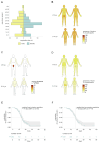Epidemiological and clinical features of mpox during the clade Ib outbreak in South Kivu, Democratic Republic of the Congo: a prospective cohort study
- PMID: 39892407
- PMCID: PMC7618259
- DOI: 10.1016/S0140-6736(25)00047-9
Epidemiological and clinical features of mpox during the clade Ib outbreak in South Kivu, Democratic Republic of the Congo: a prospective cohort study
Abstract
Background: Clade Ib, a new strain of clade I monkeypox virus, emerged in eastern DR Congo, sparking an international outbreak. Comprehensive studies are needed to assess its transmission dynamics and clinical presentation.
Methods: We did a prospective observational cohort study at Kamituga General Hospital in South Kivu, DR Congo, between May 2 and Oct 9, 2024. Sociodemographic, exposure, and clinical data were collected from mpox-suspected cases. Cases were confirmed by Xpert Mpox PCR and followed through hospitalisation and on days 29 and 59 after diagnosis.
Findings: Of the 510 suspected cases included, 407 (80%) tested positive via PCR. Among the 407 confirmed cases, 196 (48%) were women. Age distribution was bimodal, with 58 (14%) children younger than 5 years, and 267 (66%) individuals aged 15-34 years. Most cases (237 [58%] of 406) reported contact with a suspected or confirmed mpox case; primarily colleagues, spouses or sexual partners in adults, and parents or siblings in children. Self-reported comorbidities were rare (18 [5%] of 400), including 6 (2%) people infected with HIV. Prodromal symptoms were present in 331 (88%) of 375 patients, active skin lesions in 394 (97%) of 407 patients, mucosal lesions in 324 (82%) of 394 patients, and lymphadenopathy in 288 (73%) of 394 patients. In adults, 280 (89%) of 314 had genital skin lesions and mean lesion density was highest in the genital area. In contrast, only 35 (42%) of 84 children had genital lesions, as part of a more uniform rash. Among 403 hospitalised patients, two (<1%) deaths occurred. Among 296 patients with detailed hospital follow-up, complications were primarily genito-urinary (169 [57%]) or cutaneous (121 [41%]). Four (67%) of six pregnant women with recorded outcome had adverse pregnancy outcomes. On days 29 and 59, few sequelae were reported other than scars.
Interpretation: Clade Ib infections in Kamituga showed distinct clinical patterns compared with clade Ia outbreaks elsewhere in the country and the global clade IIb outbreak. In adults, the disease primarily affected the genito-urinary system, compatible with sexual transmission, whereas children mostly manifested extragenital lesions. These findings highlight the need for updated case definitions and targeted public health interventions to address evolving transmission dynamics and mitigate risks for vulnerable groups, including pregnant women and young children.
Funding: European & Developing Countries Clinical Trials Partnership (EDCTP2 and EDCTP3); Belgian Directorate-General Development Cooperation and Humanitarian Aid; Research Foundation-Flanders.
Copyright © 2025 Elsevier Ltd. All rights reserved, including those for text and data mining, AI training, and similar technologies.
Conflict of interest statement
Declaration of interests LL has received institutional consultancy fees from BioNtech and institutional research funding from Sanofi; both not relevant for this work. JK has provided expert witness reports for the Treasury Board of Canada not relevant to this work. JK has also received mpox research funding from the Canadian Institutes of Health Research and the International Development Research Centre in open funding competitions. All other authors declare no competing interests.
Figures


Comment in
-
Challenges in containing the global spread of mpox clade Ib.Lancet. 2025 Feb 15;405(10478):518-519. doi: 10.1016/S0140-6736(25)00139-4. Epub 2025 Jan 29. Lancet. 2025. PMID: 39892406 No abstract available.
References
-
- 2022-24 Mpox (Monkeypox) Outbreak: Global Trends. [cited 2024 Sep 24]. [Internet] Available from: https://worldhealthorg.shinyapps.io/mpx_global/#43_Case_profile_(overall)
-
- Thornhill JP, Barkati S, Walmsley S, Rockstroh J, Antinori A, Harrison LB, et al. Monkeypox Virus Infection in Humans across 16 Countries - April-June 2022. N Engl J Med. 2022 Aug 25;387(8):679–91. - PubMed
-
- Bangwen E, Diavita R, De Vos E, Hasivirwe Vakaniaki E, Nundu SS, Mutombo A, et al. Mpox in the Democratic Republic of Congo: Analysis of National Epidemiological and Laboratory Surveillance Data, 2010 - 2023. [cited 2024 Oct 23];2024 Available from: https://papers.ssrn.com/abstract=4954317.
Publication types
MeSH terms
Grants and funding
LinkOut - more resources
Full Text Sources
Medical

